![]()
![]()
![]()
Use LEFT and RIGHT arrow keys to navigate between flashcards;
Use UP and DOWN arrow keys to flip the card;
H to show hint;
A reads text to speech;
172 Cards in this Set
- Front
- Back
- 3rd side (hint)
|
Name. Describe this slide. What phylum is this organism in? What type of organism is it? Identify the path of water flow, pore, radial canal, incurrent canal, spongocoel, and amplibastula larvae. What body plan does it have? |
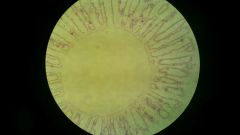
|
Scypha (Genera)with eggs. It is a calcareous sponge that can only contain syconoid body. Larvae are early embryo stage produced SEXUALLY Phylum Porifera Class Calcarea |
|
|
Name. What phylum and class is this organism in? Identify the body plan. |

|
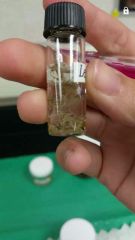
Leucosolenia. It is in the class Calcarea. Only has asconoid body plan. buds ASEXUALLY
Phylum porifera |
|
|
Name. What phylum and class is this organism in? What body plan does it hold? |

|

Grantia. Display a syconoid body plan. Class Calcarea |
|
|
Describe what is in this slide. What is their purpose? |

|
Grantia spicules. They provide structural support and deter predators. Class Calcareouos |
|
|
What phylum and class is this organism in? What type of organism is it? What is it's shape? |

|

Obelia medusa. This is a stage in the Obelia life cycle that is produced ASEXUALLY by a reproductive polyp. Phylum Cnidaria Class Hydrozoa |
|
|
Identify the structures. What organism is it? What class and phylum is it in? |
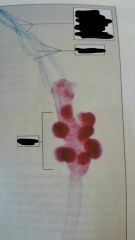
|

Hydra. Testes, tentacles, bands of singing cells containing nemastocysts. Class Hydrozoa Phylum Cnidaria |
|
|
What phylum is this organism in? What type of organism is it? What part of the life cycle is it? |
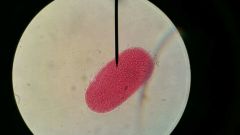
|
Aurelia planula. This is the larva stage of Aurelia that comes after the zygote. Class Scyphozoa Phylum Cnidaria |
|
|
What is this organism? What part of the life cycle is it? |

|

Aurelia scyphistoma. Stage after Aurelia planula. Now in active feeding stage. |
|
|
What is this organism. What phylum and class is it in? What part of the life cycle is it? |

|
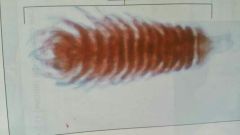
Aurelia strobila. This stage comes after Aurelia Scyphistoma. Developing medusae. Class Scyphozoa Phylum Cnidaria |
|
|
What is this organism? What phylum and class is this organism in? What part of the life cycle is it? |

|
Aurelia ephyra. This is a young medusa, after Aurelia Strobila. In this class medusa is prominant. Class Scyphozoa Phylum Cnidaria |
|
|
What phylum is this organism in? What type of organism is it? Where is the bud? |

|
Asexual hydra, ONLY has polyp form. Phylum Cnidaria Class Hydrozoa |
|
|
What phylum is this organism in? What type of organism is it? |
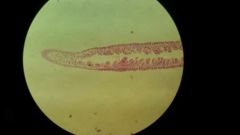
This type of cnidarian is a solitary polyp w/o medusa stage. |
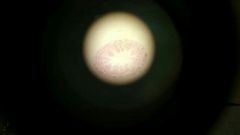
Hydra Phylum Cnidaria Class Hydrozoa |
|
|
Describe sporangia in zygomycetes. |
They can form sexually, or asexually. In culture with only one hyphae type, they will form asexually. |
|
|
|
Where are the rhizoids in zygomycetes? |

|
At the base of the sporangia-bearing hyphae. |
|
|
how are zygosporangia formed? |
1. opposite hyphae come together 2.protuberances make contact, gametangia are produced 3. wall b/w gametangia dissolves, cytoplasms mix 4. haploid nuclei fuse, EACH fushion considered a 'zygote'. Multinucleate cell is zygospore. 5. Thick wall forms. Now called zygosporangium. 6.Germination results in sporangium. |

|
|
|
Ascus |
Develops as a result of SEXUAL reproduction in ascomycetes. The sac that develops spores. |
Phylum Ascomycota |
|
|
Conidia |
Spores produced during ASEXUAL reproduction of Ascomycetes. Not formed inside sporangium, but at tip of specialized hyphae. |
|
|
|
What is an economic importance of ascomycetes? |
yeasts are crucial to baking and brewing industries. there are foods, like morels, and truffles |
|
|

Eurotium (Blue Mold) |

produces blue conidia. Where are the conidia, conidiophore, conidiospore? |
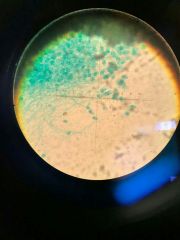
|
|
|
Ascocarp |
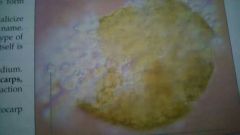
The fruiting bodies of acomycetes. Products of SEXUAL reproduction. Where is the ascocarp, ascus containing ascospores? |
|
|
|
Asci(plural) |
contain dark colored spherical ascospores |
|
|
|
What is the female/male gametangia called in ascomycetes? |
in females, ascogonium in males, antheridia |
|
|
|
Ascus (singular) in sac fungi |
fusion of paired nuclei in papilla and cell wall formation around paired nuclei. Considered zygote. |
|
|
|
Peziza |

A cup fungus. |
Phylum Ascomycota |
|
|
Ascocarp |
fruiting body, extended mycelium |
|
|
|
Identiry the structures. |

|
ascus, asci, ascospores
|
|
|
basidiocarp |
the fruiting body in club fungi. some are mushrooms. EVERY cell in it has two genetically different nuclei. |
Phylum Basidiomycota |
|
|
Identify this structure |

|
Basidium, club-shaped. nuclei fuse and form diploid basidium, which produce haploid basidiospores. Identify basidium, basidiospores, gills. |
|
|
Identify the organism. |

|

Gill fungi. The mushrooms. hyphae look like gills. Identify the stalk, gills, cap. Phylum Basidiomycota |
|
|
What is the primary phase in gill fungi? |
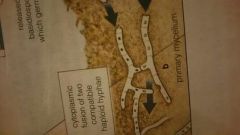
after haploid basidiospore germinates producing haploid mycelium |
|
|
|
what is the secondary phase in gill fungi? |

When two mycelia fuse and form a dikaryotic mycelia. |
|
|
|
What does shelf fungi indicate if it is living in a tree? |
The fungi is digesting the cells of the wood, so the tree is diseased. |
Type of Club fungi Phylum Basidiomycota |
|
|
What is unique of "imperfect fungi"? |
no know sexual stage. Reproduction takes place primarily by means of conidia. |
|
|
|
What is the economical importance of "Imperfect Fungi"? |
They produce antibiotics Ex) Penicillium Produces Penicilin Ex) Citric acid used in soft-drinks |
|
|
|
What is a common feature among the genus Penecillium? |
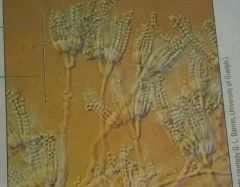
Distinctive shape of the hypha that produce the conidia. Looks like a brush. These are reproduced ASEXUALY and are "Imperfect". those that reproduced sexually are classified in ascomycota. |
|
|
|
Alternaria |
An allergy-causing organism. |
Imperfect fungi |
|
|
Identify these organisms |

Multicellular, distinct from all other fungi conidia |
Conidia of Alternaria "Imperfect fungi" |
|
|
Lichens |
Organisms made up of fungi and either green algae or cyanobacteria. fungal mycelium provide protective, moist shelter, for the photosynthesizing cells. |
Cructose lichen
|
|
|
Identify |
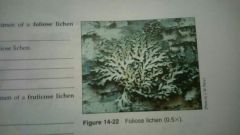
|
foliose lichen |
|
|
Identify |
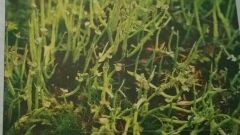
Where are the apothecia? What is it? |
fruticose lichen
|
|
|
Identify this organism and its structures |

locate the fungal mycelium, the algal cells, fruiting body |
lichen of fungal and algae cells
|
|
|
Mycorrhiza |
Means Fungus Root. Mutualistic association b/w plant roots and certain fungi. Giving phosphate ions and minerals to plant, while receiving carbohydrates |
|
|
|
Ectomycorrhizae |
produce a fungal sheath around root, penetrate cell walls of root's cortex |
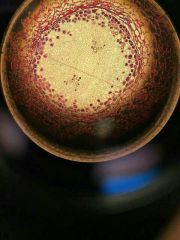
|
|
|
Endomycorrhizae |
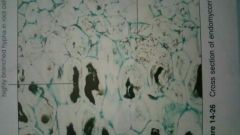
Fungi are found W/I cells of plant roots. Identify root cell, hypha |
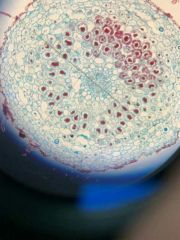
|
|
|
How does light affect fungi? |
it can trigger spore production |
|
|

What type of disease is this and what fungi caused it? |
Black wart. Chytrids. |

Phylum Chytridiomycota |
|
|
What classified chytrids? |
Flagella on spores |
|
|
|
Zygosporamgium |

Thick walled zygote produced my zygomycetes in SEXUAL Reproduction. A mutinucleate structure. First heterokaryotic with many haploid nuclei then with many diploid nuclei after karyogamy. Germinates into sporangium. |
Phylum zygomycota: Rhizopus |
|
|
Hyphae |
Tubular cell walls surrounding the plasma membrane and cytoplasm of the cell walls in fungi. |
|
|
|
Mycelium |
All hyphae together |
|
|
|
Gamitangia of zygomycetes |

|
|
|
|
Identify zygospore, Zygosporangium, hypha, hyphae. |

|
|
|
|
Life cycle of mushrooms |
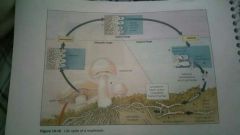
|
Phylum basidiomycota: club fungi Not all basidiomycota are mushrooms |
|
|
Morchella |

Cup fungus |
Phylum ascomycota |
|
|
Sabrobes |
Fungi that grow on non living organic matter. |
|
|
|
Parasite |
Obtain nutrients from organic material of another living organism |
|
|
|
Taxonomic separation of fungal phyla is bases on |
Sexual reproduction, or lack thereof |
|
|
|
Identify the structure |
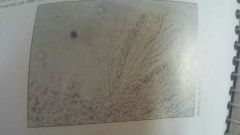
|
Cluster of asci with spores inside. Cup fungi, Peziza. Phylum ascomycota |
|
|
Larva |
Sexually immature free-living form the grows and transforms into an adult |
|
|
|
What are the three primary germ layers? What to they do? |
Ectoderm Mesoderm Endoderm Form and give rise to germ tissue |
|
|
|
Asymmetrical body form |
Cannot cut the body into two halves |
|
|
|
Radial symmetry |
any cut from the oral to the other end through the center of the animal yields to like halves |
|
|
|
Bilateral symmetry |
A cuto in only one plane, parallel to the main axes and dividing the body into right and left pieces, yields like halves |
|
|
|
Cephalization |
Bilateral symmetry accompanies the movement of sensory structures and the mouth to the front end of the body to form a head |
|
|
|
Coelom |
Ventral cavity that is lined with tissue derived from mesoderm |
|
|
|
Pseudocoelom |
Ventral cavity if the mesoderm lining is incomplete |
|
|
|
Monoecious |
Individuals have both male and female reproductive structures |
|
|
|
Dioecious |
Male and female reproductive structures are in separate sexes |
|
|
|
Pathenogenesis |
The egg develops with out fertilization, occurs sporadically |
|
|
|
What is the body organization and level of organization of sponges? |
They contain none or crude radial symmetry, they have cell specialization with no tissue. There's a division of labor among different cell types. |
Phylum Porifera |
|
|
What is a body organization and level of organization of cnidarians? |
They contain an incomplete gut and radial symmetry. Their tissue only contains ectoderm and endoderm |
Phylum Cnidaria |
|
|
What is the body organization and level of organization of flatworms? |
they have a head and a incomplete gut with bilateral symmetry, the organs organ system consists of three primary germ layers. Acoelomate |
Phylum platyhelminthes |
|
|
What is the body of organization and level of organization of rotifers? |
They have a head, complete gut, pseudocoelum, bilateral symm. And an organ System |
Phylum Rotifera |
|
|
What are animals with no coelom called? |
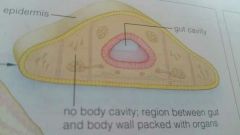
Acoelomate. No body cavity. |

|
|
|
What are animals with a pseudocoel called? |

Pseudocoelomate |

|
|
|
What are animals with a coelom called? Identify gut cavity, epidermis, peritoneum, and lined coelom |
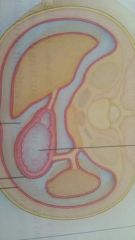
(Eu)Coelomate |
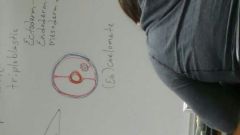
|
|
|
Identify where the mesohyle, epidermis cells, spongocoel, ambliblasrula larvae, incurrent canal, radial canal, pore, and collar cells are. What does mesohyle contain? |

Mesohyle is where ameoboid cells and spicules are contained |
Class Calcarea Phylum Poriferad |
|
|
Identify this organism. What is the purpose of each structure? Where do they reside? |

|
These are collar cells called Choanocytes that reside in the ezcurrent canals in sponges. Flagella creates current. Microvilli play a major role in filtering. |
|
|
Identify |

Flexible substance chemically similar to human hair. Found in commercial and freshwater sponges |
Spongin Class Demospongiae |
|
|
What body plan do ALL commercial and freshwater sponges have? What class are they in? |

Leuconoid body plan. Class Demospongiae. |

Commercial sponge |
|
|
Dried scypha. What is the pore looking structure? |

|
Osculum |
|
|
Identify the osculum, spicules, spongocoel, radial canal, pore, incurrent canal, epidermis, mesenchyme, Flow of water, embryo, and collar cell in scypha. |

|
|
|
|
Identify the structures: mouth, epidermis, mesoglea, gastrodermis, sheet of epidermal cells, interacting cells of nerve net, tentacles. What type of organism is it? From what class? |

|
It's a sea aemone. Class Anthozoa. |
|

|
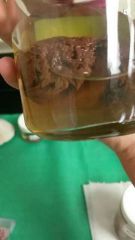
Identify this specimen and the structures. What class and phylum is it in? What is the function of the pedal disk? |
Metridium. Oral disk, mouth, pedal disk, column, tentacles. The pedal disk helps animals in this class to burrow into sand or mud. Class Anthozoa Phylum Cnidarians |
|

|
Identify this organism. Identify the structures (radial canal, ring canal, sense organs, gastrovascular cavity, tentacles, four oral arms, mouth, gonad). What phylum and class is it in? |

Aurelia. In this organism, sexes are separate. Zygote develops into Aurelia Planula, which begins the life cycle. Phylum Cnidaria Class Scyphozoa (True Jellyfish) |
|

|
What phylum and class is this individual in? What stage in the life cycle is it? Identify each part. |
Tentacles, Mouth, Manubrium, Gonad, Bell Phylum Cnidaria Class Hydrozoa |
|

|
Identity this organism. Identify the individual types of polyp |
Obelia Colonial polyps. Feeding polyp Reproductive polyp Hydrozoan w/ polyp and medusa stage. Reproduction poly contains developing medusa. |
|
|
Identify the following structures |

|
Ovary Elevation with mouth basal disk Phylum Cnidaria |
|

Identify the circular structure |
Embryo |
Phylum Cnidaria class hydrozoa |
|

|
What phylum and class is this organism in? Identify the ASEXUAL bud and the grastrovascular cavity. |
Hydra in phylum Cnidaria Class Hydrozoa |
|
|
Identify the following structures. What organism is this and from what phylum/class does it come from? |

|
Hydra Phylum Cnidaria Class Hydrozoa Epidermis, Gastrovascular Cavity (made from endodermis), Gastrodermis, Mesoglea (In Hydra is w/o cells) |
|
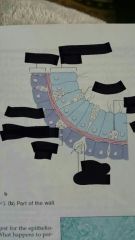
|
Identify the lining of the gastrovascular cavity, the epidermis, the gland cell, the intestinal cell, the epitheliomuscular cell, stinging cell, nematocyst, interstitial cell, epitheliomuscular cell, and mesoglea |
Hydra, part of the wall |
|
|
Identify these structures. What organisms are they in? |
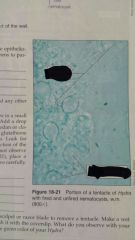
|
Portion of a Tentacle in Hydra. Fired and unfired namatocyst in stinging cells (Cnidoblast) |
|
|
Name. Identify the Structures. how does this organism move?What phylum and class is this organism in? |

Gonionemus. Epidermis, Mesoglea, Stomach, Bell, edge of velum, mouth, manubrium, radial canal lined with gastrodermis, gonad, oral lobe, ring canal, adhesive pads, tentacles |

It moves by 'jet propulsion. Phylum Cnidaria Class Hydrozoa |
|

Name. Identify the structures. What class and phylum is it in? What body forms does it contain? |
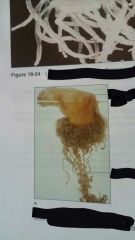
|
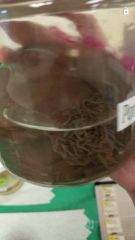
Physalia (Portuguese man-of-war). Tentacles, Gas-filled float. Has both modified polyp and medusae. Phylum Cnidaria Class Hydrozoa
|
|
|
Identify the structures. What organism do they belong to? |

|
Reproductive Polyp, modified gamete producing medusa, feeding polyp, nematocysts-studded fishing tentacle
They belong to the portuguese man-of-war |
|
|
what type of body plan is this? identify the osculum, the radial canal, incurrent canal, excurrent. canal |

|
Leuconoid body plan |
|
|
Conidia |
Spores produced during ASEXUAL reproduction of Ascomycetes or imperfect fungi. Not formed inside sporangium, but at tip of specialized hyphae. |
|
|
|
Identify the spongoceal, incurrent pore, osculum. What type of body plan is this? |
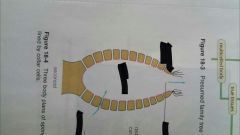
|
Asconoid |
|
|
Nematocysts |
stinging elements used to capture food by cnidarians |
|
|
|
What is this body shape? Identify the structure in it. |

|
|
|
|
Identify the two body forms of Cnidarians and identify the structures. |

|
Mouth, tentacles, outer epithelium (epidermis), mesoglea, inner epithelium (gastrodermis) |
|

Identify the mouth, epidermis, gastrodermis, gastrovascular cavity, testes, ovary, asexual bud, cnidocyte with nematocyst, and the nerve cell |

|
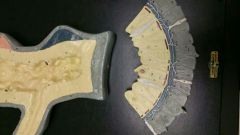
|
|
|
Spongilla |

|
Phylum Porifera |
|
|
What does the epidermis of corals secrete? |
An exoskeleton of calcium carbonate |
|
|
|
Describe the three classes of the Phylum Cnidaria? |
Class Hydrozoa: (Hydrozoans) may contanin polyp and medusa stages in life cycle Class Scyphozoa: (True Jellyfish) Medusa predominates Class Anthozoa: (Corals and Sea Anemones)All members are heavy bodied polyps |
|
|
|
Polyorchis. Hydrozoan medusa |
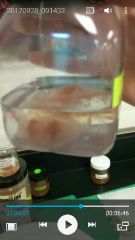
|
|
|
|
Identify this organism and the structures. What phylum and class is it in? |
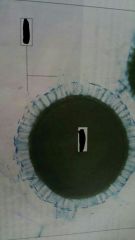
|

Leuconoid Sponge, spicules, geemmules produced by asexual reproduction. Freshwater sponge. Class Demospongiae. Phylum Porifera. |
|

|

|
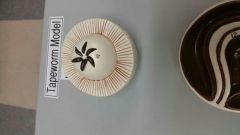
|
|

|

|

|
|

|

|
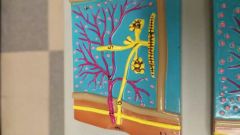
|
|
|
Identify. What are the branch looking structures? |

|
Gravid proglittid of Taenia pisiformis. Branches are zygotes in an expanded uterus ready to release eggs |
|
|
Identify this specimen and the different structures: branching gut, pharynx, protonephridia, brain, ovary, testis, oviduct, nerve cord, genital pore, penis, flame cell, opening of tubule at body surface, nucleus, cilia, fluid filters.
what genus, class, and phylum is it? |

|
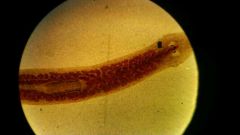
Genus Dugesia Class Turbellaria Phylum (planarians) Platyhelminthes |
|
|
Identify the organism and the structures. |

Branches of intestine, pharynx, gonad, nerve cord, pharyngeal pouch, ciliated epidermis |

Class Turbellaria (planarians) Phylum Platyhelminthes (flatworms) |
|

|

|
Metridium Class Anthozoa |
|
|
Identify this specimen. What class is it in? |
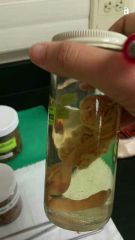
|
Stytula. Sea Pen. Class Hydrozoa.
Phylum Cnidaria |
|
|
Identify this specimen. What phylum is it in? |

|
Sea pansey. Class Anthozoa. |
|
|
Identify this specimen and its structures. What class and phylum is it in? |

Head, eyespots (photoreceptors), auricle (organs sensitive to touch) |
This is a planarian, organisms have both reproductive structures but can not self fertilize. They are regenerative. Class Turbellaria (Planarians) Phylum Platyhelminthes |
|
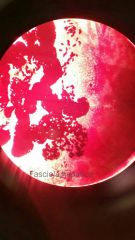
Identify this organism and its structures. What class and phylum is it? |

Mouth, oral sucker, pharynx, esophagus, intestinal ceca, cirrus pouch, uterus with eggs, ovary, shell gland, yolk duct, yolk gland, ventral sucker, edge of genital pore, cirrus everted through genital pore |

Fasciola hepatica (sheep liver fluke) Class Trematoda (flukes) Phylum Platyhelinthes |
|
|
Identify this organism and its structures. What is class and phylum is it in? |

Ovary, Seminal receptacle, uterus, genital pore, intestinal ceca, esophagus, pharynx, mouth, oral sucker, ventral sucker, yolk gland, shell gland, testes, excretory pore |
Clonorchis (Human liver fluke) Class Trematoda Phylum Platyhelminthes |
|
|
Liver fluke What class and phylum is this organism in? |

|
Class Trematoda (fluke) Phylum Platyhelminthes |
|
|
Monienza Expansa What class and phylum is this organism in? |

|
Monienza expansa. Tapeworm. Class Cestoda Phylum Platyhelminthes |
|

What life cycle is this and what does each represent?
encystment in fish muscle. this is the second intermediate host in the golden carp. After tadpolelike larvae burrow into fish. |

This stage occurs after human (host) rids the fluke. eggs develop larva and is ingested by the snail (the first intermediate host) |

After snail excrete larvae, it burrows into the golden carp
Class Trematoda Phylum Platyhelminthes Life Cycle human liver fluke (Clonorchis sinenthis)
|
|
|
What life cycle is this in? What does it represent? |

This is the final stage of the liver fluke (Clonorchis). Humans injest encystment and larvae progress into adult form. |

|
|
|
Identify the specimen and its structures. What class and phylum is it in? |

Hooks, scolex, suckers, neck, forming proglittids (immature). |
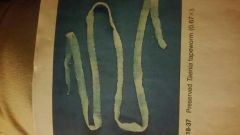
Monoecious, can self fertilize. Class Cestoda ( Tapeworms) Phylum Platyhelminthes |
|
|
Identify this organism and its structures: vas deferens (contains sperm), genital pores, vagina, testes, uterus, ovaries, ootype, yolk gland, excretory canals. |

|
Mature proglottids of Taenia pisiformis. |
|
|
Identify this organism and its structures. |
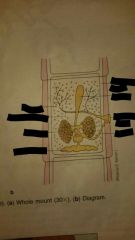
Excretory canal, uterus, genital pore, vagina, yolk gland, ovary, vas deferens, testes |
Taenia pisiformos tapeworm |
|
|
Describe this organism and its structures. What phylum is it in? |
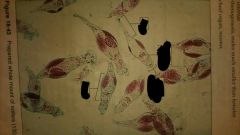
Mastax (jaws), foot, ciliated corona (wheel organ, allow movement), trunk, toes(for adhering to objects). |
Rotifers. Dioecious Phylum Rotifera. |
|
|
Describe the life cycle of the tapeworm, Taenia solium. |
1. Gravid proglottids are voided w/ human feces 2. Pig ingests proglottid, embryos escape, bladder worms insist in muscle 3. Human ingests pig, bladder worm attaches scolex to intestinal wall 4. Tapeworm matures and adds proglottids |

|
|
|
What phylum are conifers in? What is their economical importance? |
Phylum Coniferophyta. Conifers are used for construction and pulp, used to manufacture paper |
|
|
|
Identify each step of the life cycle in the Pine, including mitotic stages. Differentiate the haploid and diploid stages. |

|
Young female cone, male cone, megaspore mother cell, ovule, microsporangium (pollen sac), female gametophyte, pollen grain, pollen tube with sperm producing cell, archegonia, zygote, seed coat, embryo, female seedling, mature sporophyte. Phylum Coniferophyta |
|
|
Microsporophyllis |
The scale-like structures that make up the cone in gymnosperms |
|
|
|
Identify this specimen and its structures. |

|
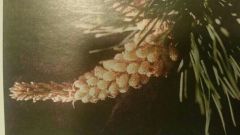
gymnosperm male cone strobilius. Cone axis and microsporophyllis |
|
|
Identify this specimen and its stuctures |

|
Pollen grain. Made up of four cells.
Tube cell, generative cell, wing |
|

Identify this specimen and its structures |
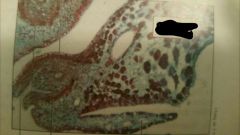
|
Female gymnosperm cone. Ovuliferous scale, ovule, sterile bract, integument, megaspore mother cell, megasporangium, microphyte |
|
|
Identify this specimen and its structures |

|
Female gymnosperm cone. archegonia, female gametophyte, integument, ovuliferous scale, egg, egg nucleus |
|
|
What stage in the life cycle is this? What are the structures. What will be the product of this stage? |

|
Fertilization, fusion of egg and sperm in gymnosperms. Pollen tube, sperm, egg cell nucleus. Zygote results. |
|
|
Identify this specimen and its structures. |

|
Gymnosperm pine seed. Cotyledons, epicotyl, hypocotyl-root axis, female gametophyte, megasporangium, embryo |
|
|
What are the two functions of cotyledons? |
To absorb nutrients stored in female gametophyte during germination. They are the first leaves, turning green when exposed to light. |
|
|
|
What phylum are Zamia and Cycas in? How do they differ from conifers? |
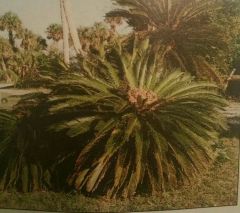
Cycads |

Zamia. Phylum Cycadophyta. They have different female and male plants. |
|
|
Identify this gymnosperm. What is unique about it? |

|

Ginkgo biloba. It is the only species remaining in the phylum Ginkgophyta |
|
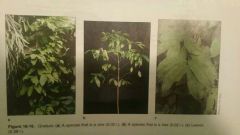
Identify these plants. What is unique about them? What phylum are they in? |
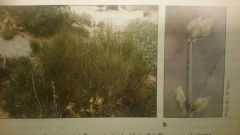
Ephedra |
Gnetophytes in phylum Gnetophyta. They have characteristics found only angiosperms. Their reproduction structures look more like flowers than cones. |
|
|
What organism does this life cycle belong to? Identify the stages. What phylum is it in? |

|
Ascomycetes. Phylum Ascomycota |
|
|
Identify these stages. From what life cycle is it? |

|

|
|
|
Describe three ways sponges reproduce. |
ASEXUAL Budding: Parent cells differentiate and grow outward Forming ASEXUAL gemmules: resistant internal buds SEXUAL reproduction: by forming amphiblastula larvae in radial canal |
|
|
|
List six characteristics of the animals kingdom. |
Multicellular heterotrophic oxygen-consuming exhibit considerable motility Period of embryonic development, often with larva Most animals have three germs layers |
|
|
|
Describe several adaptations of parasitic flatworms (flukes) to their external environment |
noncellular cuticle covers the surface of their bodies |
|
|
|
Describe the reproductive structure, source of nutrition for developing embryo, and enclosure of mature seed for an angiosperm |
Reproductive structures: stamen and pistil. Nutrition: Endosperm Enclosure of mature seed: integuments from parent sporophyte (placenta) |
|
|
|
Distinguish between pollination, germination, and fertilization |
Pollination is the transfer of pollen from the microsporangia to the stigma. Germination occurs when tube cells expands to make a tube, then generative cells divided into two sperm (at this stage it is not a mature male gametophyte). |
Fertilization is when the sperm nuclei fuses with the haploid egg nucleus by the micropyle, forming a diploid zygote. |
|
|
Some biologists contend that the term double fertilization is a misnomer and that the process should be called fertilization and triple fusion. Why do they argue that the fusion of fusion of the one sperm nucleus and the two polar nuclei are not fertilization. |
Because only the egg is getting fertilized to form a zygote. The two polar nuclei are not getting fertilized to form an organism, rather they will only produce endosperm that will serve as food for embryo. |
|
|
|
What does angiosperm mean? |
vessel seed. refers to seeds borne w/i a fruit |
|
|
|
What are the sterile parts of the flower? |
Corolla and calyx |
|
|
|
What are the stamens? What do they contain? |
Microspore-bearing leaves, or microsporophylls. They contain anthers, which contain microsporangia (pollen sacs). |
|
|
|
What are carpels? How can you distinguish how many carpels are in a flower? |
Megasporophylls. By counting how many lobes of the stigma there are. |
|
|
|
What are two groups of flowers? |
Monocotyledons, which usually have flower parts in multiples of threes. Dicotyledons have parts in multiples of four or fives or multiples thereof. |
Monocots and diocots |
|
|
What does microsporangium in angiosperms contain? |
Depending on the stage, either a diploid microspore mother cell or haploid microspores, which develop into pollen grain. |
|
|
|
How many cells do pollen grain contain? |
Only two cells, the large tube cell and the smaller generative cell. |
|
|
|
What does each ovule contain in angiosperms? |
Megasporangium, the outer cell layers of which forms two flaps of tissue called integuments. Diploid megaspore mother cell |
|
|
|
Micropyle |
The small opening that remains after integuments envelop megasporangium in angiosperms. |
|
|
|
What does a megaspore mother cell produce in angiosperms? |
After meiosis, it produces four nuclei, now called the female gametophyte (embryo sac). three nuclei fuse, forming one 3n nucleus, and one 1n nucleus. |
|
|
|
Why do they call the mature female gametophyte of angiosperms a seven-celle, 8 nucleate gametophyte? |
Because it contains two polar nuclei (one triploid, one haploid), egg cell (haploid), central cell |
|
|
|
What happens when the male gametophyte in angiosperms release their two nuclei? |
One fuses with an egg to form a zygote. The other fuses with the polar nuclei to form the endosperm mother cell, which will then form the endosperm (tissue to nourish embryo). |
This is called Double Fertilization. |
|
|
What are the four stages of embryo development in angiosperms? |
1. Globular stage (large basal cell active in uptake of nutrients for embryo) 2. Heart-shaped stage (you can distinguish cotyledons) 3. Torpedo stage (Embryo elongated) 4. mature embryo |
|
|
|
What are mature ovaries and ovules called in angiosperms? |
Fruit is a mature ovary. Seed a mature ovule. |
|
|
|
Define annual plants, biennials, and perennials. |
Annual plants complete their life cycle in their growing season. Biennials grow vegetatively during first growing season, and don't produce flowers or seeds until the second growing season. They both die after seeds are produced. Perennials live several years, time b/w germination and flowering varies. They do not die after producing seeds. |
|
|
|
Diploblastic |
Having only two main tissues |
|
|
|
Triploblastic |
Having ectoderm, mesoderm, and endoderm |
|
|
|
Mesoderm |
Holds gut in place |
|
|
|
Protonephridia |

Set of tubes involved in water control. On cell on it, flame cell caused current to suck in excess water so it can be excreted. 1st excretory system. |
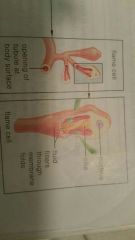
|
|
|
Describethree ways that sponges reproduce.
|
1. Asexual:They can reproduce by budding. 2. Sexual: Malegametes can be released into the water and absorbed by a female sponge, whichthen produces amphibalstulate larvae. They can be excreted from the osculum. 3. Asexual:Some species can produce internal buds called gemmules. |
|
|
|
Contrast (show the differences using completesentences) the digestive systems of free-living and parasitic flatworms structurally and functionally.
|
Free-livingflatworms do not live inside a host like parasitic flatworms do. They need tofind their own food. As a result, free-living flatworms have larger branchingguts with enzymes to break down food. Parasites absorb nutrients that arealready broken down in a host fairly easy, so the digestive system becomesreduced and no longer greatly branched.
|
|
|
|
Which phylums have an incomplete gut? |
Cnidarians and Platyheminthes |
|

